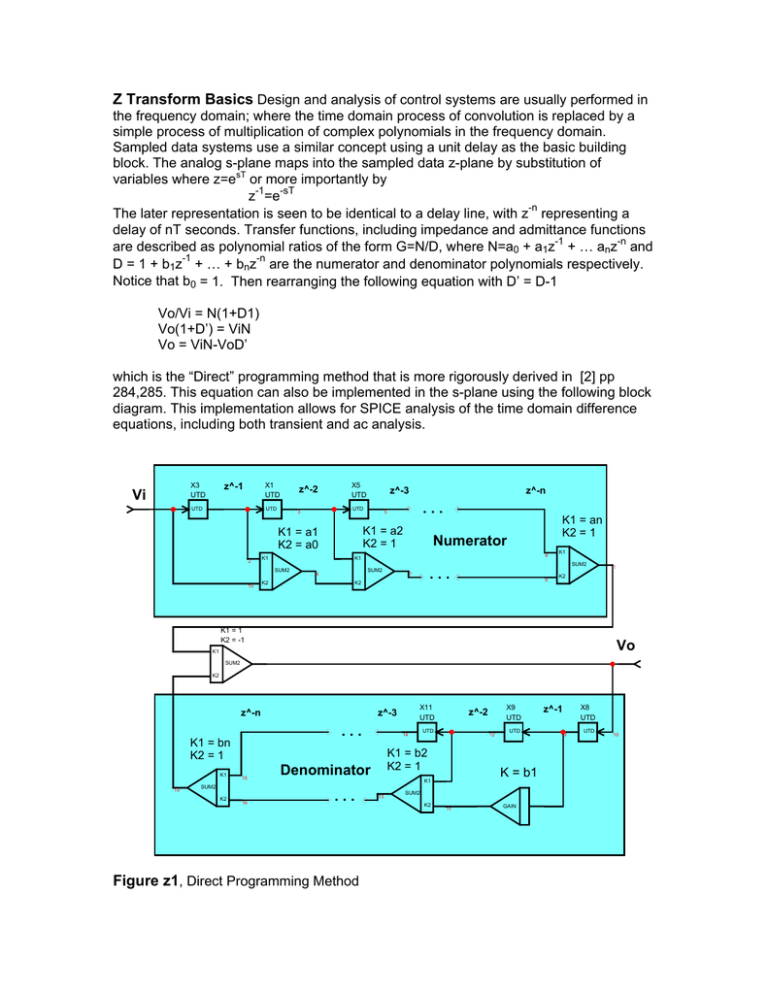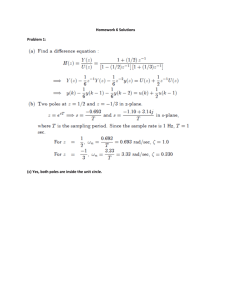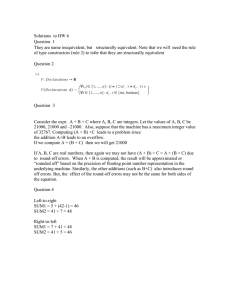. . . . . . . . . . . . Numerator Denominator Vi Vo
advertisement

Z Transform Basics Design and analysis of control systems are usually performed in
the frequency domain; where the time domain process of convolution is replaced by a
simple process of multiplication of complex polynomials in the frequency domain.
Sampled data systems use a similar concept using a unit delay as the basic building
block. The analog s-plane maps into the sampled data z-plane by substitution of
variables where z=esT or more importantly by
-1
-sT
z =e
-n
The later representation is seen to be identical to a delay line, with z representing a
delay of nT seconds. Transfer functions, including impedance and admittance functions
-1
-n
are described as polynomial ratios of the form G=N/D, where N=a0 + a1z + … anz and
-1
-n
D = 1 + b1z + … + bnz are the numerator and denominator polynomials respectively.
Notice that b0 = 1. Then rearranging the following equation with D’ = D-1
Vo/Vi = N(1+D1)
Vo(1+D’) = ViN
Vo = ViN-VoD’
which is the “Direct” programming method that is more rigorously derived in [2] pp
284,285. This equation can also be implemented in the s-plane using the following block
diagram. This implementation allows for SPICE analysis of the time domain difference
equations, including both transient and ac analysis.
z^-1
X3
UTD
Vi
X1
UTD
UTD
z^-2
UTD
X5
UTD
3
K1
18
...
5
K1 = an
K2 = 1
Numerator
8
K1
SUM2
K2
z^-n
K1 = a2
K2 = 1
K1 = a1
K2 = a0
2
z^-3
UTD
SUM2
4
SUM2
...
7
K2
K1
6
1
K2
K1 = 1
K2 = -1
Vo
K1
SUM2
K2
z^-n
...
K1 = bn
K2 = 1
K1
19
15
SUM2
K2
16
X11
UTD
z^-3
14
UTD
12
K1 = b2
K2 = 1
Denominator
Figure z1, Direct Programming Method
13
UTD
K = b1
K1
...
X9
UTD
z^-2
SUM2
K2
11
GAIN
z^-1
X8
UTD
9
UTD
10
Bilinear Transform Solving for s as a function of z yields
s=(1/T)ln(z)
The ln(z) function can be broken down into 2 common approximations. Lets first do this
by using the first term of the series expansion where ln(z) = 2(z-1)/(z+1). Then let z+1 =
2z to further simplify to ln(x)=(z-1)/z. So that
s=(1/T)(z-1)/z
s=(2/T)(z-1)/(z+1)
The first representation is the one commonly used [2] pg 60 in the z-transform tables.
Mathematically it is common to let T = 1 and omit it from the tables, leaving it to the user
to scale the result for other sample frequencies. This scaling is quite valuable for
evaluating high order polynomials where preventing numerical overflow is important; but
the work presented here will never go beyond first order polynomials so the value for T
will be retained. Restating the above equations to represent integration and delays
yields:
-1
1/s=T(1/(1- z ))
-1
-1
1/s=T/2(1+ z )/( 1- z )
Rectangular integration
(z Transform)
Trapezoidal integration
(Bilinear transform)
There are 2 interpretations to these equations in terms of integration method, although
they were derived here from a series expansion; they could have also been derived in
time domain using rectangular and trapezoidal integration methods. Figure z2 shows the
results for a continuous time integration of current through a 1 uHy inductor vs. the z
transform method. The z transform uses a 100kHz sample rate.
1 ph_is
2 db_is
3 ph_iz
4 db_iz
350
80.0
40.0
0
-40.0
-80.0
db_iz, db_is in dB
Plot1
ph_iz, ph_is in degrees
4
2
3
1
250
150
z-plane magnitude
s plane magnitude
z-plane phase
s-plane phase
50.0
-50.0
10k
20k
50k
frequency in hertz
100k
Figure z2, Z Transform of an integrator compared with continuous time integration
Figure z3 shows the bilinear transform method in which the phase lags 90 degrees up to
½ the sample frequency. Its magnitude function goes to zero at ½ the sample frequency.
2 db_is
120
60.0
0
-60.0
-120
72.0
db_izb, db_is in dB
Plot1
ph_izb, ph_is in degrees
1 ph_is
48.0
3 ph_izb
4 db_izb
z-plane phase
4
2
3
s-plane phase 1
s-plane magnitude
24.0
0
-24.0
z-plane magnitude
10k
20k
50k
frequency in hertz
100k
Figure z3, Bilinear transform of integrator compared with continuous time integration
These figures illustrate why most designers favor the bilinear transform for low pass
filters. The filter attenuation actually increases when compared with the same linear
design and out of band signals near ½ the sampling frequency are attenuated. That
makes the anti-aliasing filter easier to design. For control systems, the gain margin
increases, in some cases improving response time.
As frequency increases past ½ the sampling frequency, aliasing causes the results
repeat as shown in figure z4.
1/(2T)
1/(2T)
1/T
2/T
-1/(2T)
Frequency out of a switched network
Switching Frequency
Frequency into a switched network
Figure z4, Time domain frequency out vs. frequency in for sample data systems.
While the information bandwidth doesn’t exceed ½ the switching frequency, there is
indeed information contained above the sampling frequency. Z-transforms can be used
to described heterodyned signal detection by placing an analog bandpass filter about the
center frequency of interest followed by a digital lowpass filter. Moreover, the samples
can be separated by 90 deg (in time), with the in phase component representing real
numbers and the delayed sample data being imaginary numbers. A Fourier transform
converts the complex time data to the frequency domain where it can be filtered. Then
an inverse fourier transform recovers the filtered time dependant data. If certain rules are
followed, there will be no imaginary data in the time domain.
z-plane frequency warping As shown previously in Figures z2 and z3, s-plane poles
and zeros ranging to infinity are warped into the z plane. Mathematically, the warping is
described by evaluating the s-plane frequency for s = jw and the z-plane frequency =
jwz.
jw=(2/T)*(e^(jwz*T-1)/( e^(jwz*T-1)
Multiplying numerator and denominator by 1/2*e^(-jwz*T/2) gives
w=2/T*sin(wz*T/2)/cos(wz*T/2)
w= c *tan(wz*T/2) or wz=2/T*atan(w/c), c=2/T
Now, the z-plane argument is phase going from –pi/2 to pi/2 as s-plane frequency goes
from – infinity to + infinity.
Figure z5 illustrates this warping. Importantly the warping maps each s-plane frequency
to a unique z-plane frequency. Filters such as Chebyshev, Butterworth and Elliptical can
be mapped into the z-plane such that filter cutoff frequencies are the same by adjusting
c. The filter will then have a somewhat sharper cutoff than its corresponding s-plane filter
because frequencies approaching infinity are compressed to ws/2.
1 fz
1
45.0k
Plot1
fz
35.0k
25.0k
15.0k
T=10u
c=2/T
f = 1k*(1m+vector(1000))
fz=2/T*atan(2*pi*f/c)*pi/180/2/pi
plot fz f
5.00k
0
500k
f
1.00Meg
Figure z5, Bilinear transform maps s-plane frequency, f to sampled frequency fz for
c=2/T.
The script shown in figure z5 was used to plot the graph in IntuScope. Notice that angles
are in degrees, the pi/180 correct this and frequency is converted from 1/sec to Hertz by
scaling w = 2*pi*f.
To recap; when transforming from continuous to sampled systems, the poles or zeros at
infinity move to the nyquist frequency (1/2 the sampling frequency) in the z-plane. For
low-pass filters, there are zeros at infinity so that the signals near the nyquist frequency
go to zero. The frequency warping between z-plane and s-plane is approximately linear
for low frequencies; but s-plane frequencies get compressed near the nyquist frequency
and show different behavior depending on the approximation used for ln(z).The constant
c can be adjusted to make fz = f at a single frequency. Analog filters are needed to
select the appropriate frequency range and are usually low pass, rejecting signals >
1/(2*T)
R1
.025
VM
1
IVM2
V1
unknown
V3
3
C1
300u
4
R2
.02
0
-100
-200
-300
-400
db_v3, db_v21
L1
75u
ph_v3, ph_v21
Vin
60.0
20.0
-20.0
-60.0
-100
100
Parameters
L=75u
R1=.025
C1=300u
R2=.02
T=10u
X11
SUM2
K1 = 1
K2 = -1
X4
SUM2
K1 = 1
K2 = 1
K1
SUM2
1k
10k
100k
frequency in hertz
X5
SUM2
K1 = 1
K2 = -1
E2
{1/15.025}
12
K1
X2 UTD
K2
SUM2
Vd1
K2
UTD
I2
SUM2
K1
K2
16
E1
{-14.975/15.025}
1/(R1+2*L/T)
X6
UTD
15
14
Add ILoad in here
X8
SUM2
K1 = -0.00333333
K2 = 0.0366667
X7
UTD
UTD
UTD
(R1-2*L/T)/(R1+2*L/T)
17
X9
SUM2
K1 = 1
K2 = 1
K1
SUM2
K1
18
T/2/C-R2
T/2/C+R2
V21
SUM2
K2
19
K2
7
X10
UTD
UTD
Bilinear Z Transform of PWM Output Filter



